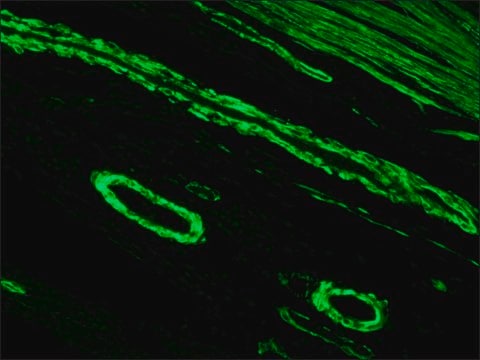P8333
Anti-Protein Kinase Cδ antibody produced in rabbit
whole antiserum
Synonym(s):
Anti-PKC δ
Sign Into View Organizational & Contract Pricing
All Photos(1)
About This Item
Recommended Products
biological source
rabbit
conjugate
unconjugated
antibody form
whole antiserum
antibody product type
primary antibodies
clone
polyclonal
contains
15 mM sodium azide
species reactivity
rat
technique(s)
dot blot: 1:50,000
microarray: suitable
western blot: 1:10,000 using rat brain extract
UniProt accession no.
shipped in
dry ice
storage temp.
−20°C
target post-translational modification
unmodified
Gene Information
rat ... Prkcd(170538)
Related Categories
General description
Protein Kinase C (PKC) is a family of serine/threonine (Ser/Thr)-specific protein kinases. PKC is a phospholipid-dependent enzyme, activated by the lipid 1,2-diacylglycerol (DAG). The protein kinase C delta (PKC δ) isoenzyme appears to be widely expressed in the brain, lung, heart, spleen, liver, ovary, pancreas, thymus, adrenal gland, skin and rat embryonic fibroblasts, and is expressed in lower levels in certain mouse fibroblasts. PKD is also located in the cytosol, nuclear compartment and in mitochondria in response to cellular stress.
Specificity
Anti-Protein Kinase C δ specifically reacts in dot-blot immunoassay with PKC δ peptide conjugated to BSA with 1-ethyl-3-(3-dimethylamino-propyl)-carbodiimide (EDCI).
Immunogen
Synthetic peptide corresponding to the C-terminal variable (V5) region (amino acids 662-673) of rat PKC δ coupled to KLH with glutaraldehyde.
Application
Anti- protein kinase c δ antibody may be used in:
- immunoprecipitation
- immunohistochemistry
- immunoblotting
- ELISA
- chemiluminescence detection systems to detect PKC δ
- dot-blot immunoassay
Applications in which this antibody has been used successfully, and the associated peer-reviewed papers, are given below.
Western Blotting (1 paper)
Western Blotting (1 paper)
Biochem/physiol Actions
Protein Kinase C isotype δ (PKCδ) modulates the inflammatory response. It acts as a signal transducer of several signaling pathways. Hence it can be considered as a vital therapeutic target to treat sepsis induced-lung injury. In sepsis, PKCδ participates in platelet-mediated activation. Overexpression and stimulation of PKC δ leads to cell division arrest in Chinese hamster ovary (CHO) cells and growth inhibition of NIH3T3 cells.
Protein kinase C (PKC) has a pivotal role in cell growth and differentiation, modulation of neurotransmission, signal transduction and oncogenesis. Anti-protein kinase c δ antibody can be used for studying the differential tissue expression and intracellular localization of PKC δ. It can also be used in western blotting and microarray.
Physical form
Rabbit Anti-Protein Kinase C δ is supplied as liquid containing 0.1% sodium azide as preservative.
Storage and Stability
For continuous use, store at 2-8 °C for up to one month. For extended storage freeze in working aliquots. Repeated freezing and thawing is not recommended.Storage in "frost-free" freezers is not recommended. If slight turbidity occurs upon prolonged storage, clarify the solution by centrifugation before use.
Disclaimer
Unless otherwise stated in our catalog or other company documentation accompanying the product(s), our products are intended for research use only and are not to be used for any other purpose, which includes but is not limited to, unauthorized commercial uses, in vitro diagnostic uses, ex vivo or in vivo therapeutic uses or any type of consumption or application to humans or animals.
Not finding the right product?
Try our Product Selector Tool.
Certificates of Analysis (COA)
Search for Certificates of Analysis (COA) by entering the products Lot/Batch Number. Lot and Batch Numbers can be found on a product’s label following the words ‘Lot’ or ‘Batch’.
Already Own This Product?
Find documentation for the products that you have recently purchased in the Document Library.
Ikuko Koyama-Honda et al.
Autophagy, 9(10), 1491-1499 (2013-07-26)
Autophagosome formation is governed by sequential functions of autophagy-related (ATG) proteins. Although their genetic hierarchy in terms of localization to the autophagosome formation site has been determined, their temporal relationships remain largely unknown. In this study, we comprehensively analyzed the
Protein kinase D activation induces mitochondrial fragmentation and dysfunction in cardiomyocytes
Jhun BS, et al.
The Journal of Physiology, 596(5), 827-855 (2018)
Junping Zhang et al.
Molecular therapy. Methods & clinical development, 32(1), 101215-101215 (2024-03-11)
The unique palindromic inverted terminal repeats (ITRs) and single-stranded nature of adeno-associated virus (AAV) DNA are major hurdles to current sequencing technologies. Due to these characteristics, sequencing noncanonical AAV genomes present in AAV vector preparations remains challenging. To address this
Peidu Jiang et al.
Molecular biology of the cell, 25(8), 1327-1337 (2014-02-21)
Membrane fusion is generally controlled by Rabs, soluble N-ethylmaleimide-sensitive factor attachment protein receptors (SNAREs), and tethering complexes. Syntaxin 17 (STX17) was recently identified as the autophagosomal SNARE required for autophagosome-lysosome fusion in mammals and Drosophila. In this study, to better
Role of Protein Kinase C-delta in regulating platelet activation and platelet-leukocyte interaction during sepsis
Liverani E, et al.
Testing, 13(4), e0195379-e0195379 (2018)
Our team of scientists has experience in all areas of research including Life Science, Material Science, Chemical Synthesis, Chromatography, Analytical and many others.
Contact Technical Service






